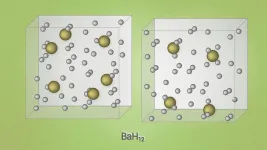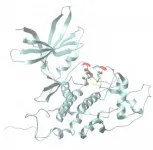(Press-News.org) Scientists are combining artificial intelligence and advanced computer technology with biological know how to identify insects with supernatural speed. This opens up new possibilities for describing unknown species and for tracking the life of insects across space and time
Insects are the most diverse group of animals on Earth and only a small fraction of these have been found and formally described. In fact, there are so many species that discovering all of them in the near future is unlikely.
This enormous diversity among insects also means that they have very different life histories and roles in the ecosystems.
For instance, a hoverfly in Greenland lives a very different life than a mantid in the Brazilian rainforest. But even within each of these two groups, numerous species exist each with their own special characteristics and ecological roles.
To examine the biology of each species and its interactions with other species, it is necessary to catch, identify, and count a lot of insects. It goes without saying that this is a very time-consuming process, which to a large degree, has constrained the ability of scientists to gain insights into how external factors shape the life of insects.
A new study published in the Proceedings of the National Academy of Sciences shows how advanced computer technology and artificial intelligence quickly and efficiently can identify and count insects. It is a huge step forward for the scientists to be able to understand how this important group of animals changes through time - for example in response to loss of habitat and climate change.
Deep Learning
"With the help of advanced camera technology, we can now collect millions of photos at our field sites. When we, at the same time, teach the computer to tell the different species apart, the computer can quickly identify the different species in the images and count how many it found of each of them. It is a game-changer compared to having a person with binoculars in the field or in front of the microscope in the lab who manually identifies and counts the animals", explains senior scientist Toke T. Høye from Department of Bioscience and Arctic Research Centre at Aarhus University, who headed the new study. The international team behind the study included biologists, statisticians, and mechanical, electrical and software engineers.
The methods described in the paper go by the umbrella term deep learning and are forms of artificial intelligence mostly used in other areas of research such as in the development of driverless cars. But now the researchers have demonstrated how the technology can be an alternative to the laborious task of manually observing insects in their natural environment as well as the tasks of sorting and identifying insect samples.
"We can use the deep learning to find the needle in the hay stack so to speak - the specimen of a rare or undescribed species among all the specimens of widespread and common species. In the future, all the trivial work can be done by the computer and we can focus on the most demanding tasks, such as describing new species, which until now was unknown to the computer, and to interpret the wealth of new results we will have" explains Toke T. Høye.
And there is indeed many tasks ahead, when it comes to research on insects and other invertebrates, called entomology. One thing is the lack of good databases to compare unknown species to those which have already been described, but also because a proportionally larger share of researchers concentrate on well-known species like birds and mammals. With deep learning, the researchers expect to be able to rapidly advance knowledge about insects considerably.
Long time series are necessary
To understand how insect populations change through time, observations need to be made in the same place and in the same way over a long time. It is necessary with long time series of data.
Some species become more numerous and others more rare, but to understand the mechanisms that causes these changes, it is critical that the same observations are made year after year.
An easy method is to mount cameras in the same location and take pictures of the same local area. For instance, cameras can take a picture every minute. This will give piles of data, which over the years can inform about how insects respond to warmer climates or to the changes caused by land management. Such data can become an important tool to ensure a proper balance between human use and protection of natural resources.
"There are still challenges ahead before these new methods can become widely available, but our study points to a number of results from other research disciplines, which can help solve the challenges for entomology. Here, a close interdisciplinary collaboration among biologists and engineers is critical", says Toke T. Høye.
INFORMATION:
Contact:
Senior scientist, Toke T. Høye, Aarhus University, Denmark tth@bios.au.dk, +45 30183122.
Link to the paper: https://www.pnas.org/content/118/2/e2002545117
A new study conducted at the New England Aquarium finds that as climate change causes the ocean to warm, baby sharks are born smaller, exhausted, undernourished, and into environments that are already difficult for them to survive in.
In a recently published paper in the journal Scientific Reports, lead author Carolyn Wheeler, a Ph.D. candidate at the University of Massachusetts Boston and at the ARC Centre of Excellence for Coral Reef Studies at James Cook University, examined the effects of increased temperatures on the growth, development and physiological performance of epaulette ...
It's been more than a year since the first cases were identified in China, yet the exact origins of the COVID-19 pandemic remain a mystery. Though strong evidence suggests that the responsible coronavirus originated in bats, how and when it crossed from wildlife into humans is unknown.
In a study published online Jan.12 in the journal mBio, an international team of 15 biologists say this lack of clarity has exposed a glaring weakness in the current approach to pandemic surveillance and response worldwide.
In most recent studies of animal-borne pathogens with the potential to spread to humans, known as zoonotic pathogens, physical specimens of suspected wildlife ...
Exercising regularly is one of the best defences against metabolic diseases, such as obesity and diabetes - but why? It's a question that scientists are still struggling to answer. While exercising changes the molecular behaviour of muscles, it's not well understood how these molecular changes improve metabolic health.
Scientists at the University of Copenhagen have now developed a new technology that allows researchers to study muscle biology on a more detailed level - and hopefully find some new answers. They extracted 'fast' and 'slow' twitch muscle fibers from freeze-dried muscle samples that were taken before and after 12 weeks of cycling exercise training. Their comprehensive analysis of the protein expression of the fibers provides new evidence that the ...
BOSTON -- By mid-November, the Centers for Disease Control and Prevention had reported that 218,439 health care workers in the U.S. had been infected with COVID-19 -- a likely underestimate due to incomplete data from states. About 3% to 4% of health care personnel who recover from coronavirus infection are expected to become "COVID long-haulers" as they cope with debilitating symptoms 12 to 18 months after the acute stage of the infection clears.
"As COVID-19 surges again, hospitals are facing a shortage of skilled frontline providers who can meet the relentless demands of caring for these patients," says Zeina N. Chemali, MD, MPH, a psychiatrist and neurologist at Massachusetts ...
A group of scientists from Russia, China, and the United States predicted and then experimentally obtained barium superhydrides' new unusual superconductors. The study was published in Nature Communications.
Chemists and physicists have been hunting down room-temperature superconductors since the first half of the 20th century. Initially, high hopes were placed on metallic hydrogen, but solid metallic hydrogen can become superconducting only at extremely high pressures of several million atmospheres, as it later transpired. Chemists then tried adding other elements to hydrogen in the hope of attaining superconductivity by stabilizing the metallic state under less challenging conditions. ...
Typically characterized as poisonous, corrosive and smelling of rotten eggs, hydrogen sulfide's reputation may soon get a face-lift thanks to Johns Hopkins Medicine researchers. In experiments in mice, researchers have shown the foul-smelling gas may help protect aging brain cells against Alzheimer's disease. The discovery of the biochemical reactions that make this possible opens doors to the development of new drugs to combat neurodegenerative disease.
The findings from the study are reported in the Jan. 11 issue of the Proceedings of the National Academies of Sciences.
"Our new data firmly link aging, neurodegeneration and cell signaling using hydrogen sulfide and other gaseous molecules within the cell," says Bindu Paul, M.Sc., Ph.D., faculty ...
Climate changes prompt many important questions. Not least how it affects animals and plants: Do they adapts, gradually migrate to different areas or become extinct? And what is the role played by human activities? This applies not least to Greenland and the rest of the Artic, which are expected to see the greatest effects of climate changes.
'We know surprisingly little about marine species and ecosystems in the Arctic, as it is often costly and difficult to do fieldwork and monitor the biodiversity in this area', says Associate Professor of marine mammals and instigator of the study ...
Researchers from Skoltech and their colleagues have optimized data analysis for a common method of studying the 3D structure of DNA in single cells of a Drosophila fly. The new approach allows the scientists to peek with greater confidence into individual cells to study the unique ways DNA is packaged there and get closer to understanding this crucial process's underlying mechanisms. The paper was published in the journal Nature Communications.
The reason a roughly two-meter-long strand of DNA fits into the tiny nucleus of a human cell is that chromatin, a complex of DNA and proteins, packages it ...
A study of students at seven public universities across the United States has identified risk factors that may place students at higher risk for negative psychological impacts related to the COVID-19 pandemic. Factors associated with greater risk of negative impacts include the amount of time students spend on screens each day, their gender, age and other characteristics.
Research has shown many college students faced significant mental health challenges going into the COVID-19 pandemic, and experts say the pandemic has added new stressors. The findings, published in the journal PLOS ONE, could help experts tailor services ...
Announcing a new publication for Marine Life Science & Technology journal. In this research article the authors Hungchia Huang, Jinpeng Yang, Shixiang Huang, Bowei Gu, Ying Wang, Lei Wang and Nianzhi Jiao from Xiamen University, Xiamen, China and Sun Yat-Sen University, Guangzhou, China consider the spatial distribution of planktonic ciliates in the western Pacific Ocea: along a transect from Shenzhen (China) to Pohnpei (Micronesia).
Planktonic ciliates have been recognized as major consumers of nano- and picoplankton in pelagic ecosystems, playing pivotal roles in the transfer ...





